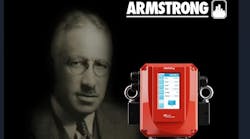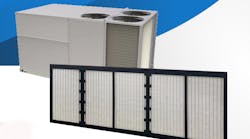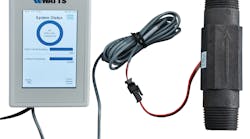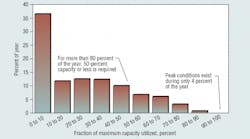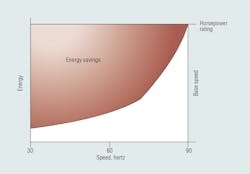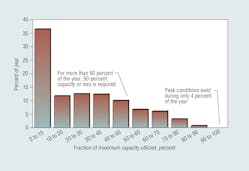The use of variable-frequency drives (VFDs) in supermarkets to control compressor and fan motors has become a key factor in reducing energy costs, enhancing product life and salability, and improving equipment service life. For outdoor condensers, drives utilizing variable-speed operation have made important contributions to noise abatement.
LOAD CONDITIONS
Refrigeration systems are designed for full-load conditions. Most of the time, however, their loads are average, not peak, and full motor capacity is not required. During average conditions, motors in traditionally designed systems (without VFDs) either constantly are running at a higher speed than necessary or frequently cycling on and off.
- For a 2021 update on the transition to low-GWP refrigerants, click here.
Producing more capacity than needed wastes considerable energy, and frequent on/off cycling accelerates wear and shortens the useful life of motors, contactors, and other components. Frequently starting and stopping motors and continually accelerating them to full speed eliminates opportunities for reducing energy costs. VFDs can help in both of these areas as well as provide better product environments.
Although maximum-load conditions — high ambient temperature, high humidity, and fully loaded store fixtures and storage boxes — exist as little as 4 percent of running time, refrigeration systems must be designed to cope with them. However, it is just as desirable for systems to provide as much of the required capacity for expected part-load conditions as possible. Unfortunately, providing capacity to meet peak demands wastes considerable energy when part-load conditions exist, if machines simply are switched on and off.
SUPERMARKET REFRIGERATION SYSTEMS
During the 1980s, many supermarket installations had one condensing unit for each circuit, and each condensing unit had a single compressor. Control was provided by the same type of low-pressure switch found today (often as a backup for microprocessor control). There were two major problems with these kinds of systems: A lot of cycling occurred, and, when a compressor broke down, the circuit was left without refrigeration.
Strategies first began to improve with the advent of twin-compressor systems. These delivered at full or half capacity, and there were fewer, although still significant, cycling problems under light-load conditions. Product losses caused by failed compressors lessened considerably.
With the arrival of three-compressor racks, compressors used in conjunction most often were of equal capacity (such as three 10-hp compressors), delivering four capacities to circuits. (Multiple circuits often were served by one rack.) For example, three 10-hp compressors had four capacities of 0, 10, 20, or 30 hp. Designers also built racks with unequal-sized compressors using, for example, one 10-hp and two 20-hp units able to deliver 0, 10, 20, 30, 40, or 50 hp in various combinations. Quadruple racks with four compressors that offered 10 or more capacities, depending on the size of the available compressors, followed.
Control of uneven parallel racks presented a complex engineering challenge that, beginning in the 1980s, was met by the application of microprocessor controllers with software that has continued to grow in sophistication and capability. Stable, reliable sensors now provide control-system software with temperature and pressure information for accurate, repeatable control.
The larger the number of capacity steps available to a refrigeration system, the closer the system can match the changing load. Using only needed capacity saves considerable energy (Figure 1).
The application of a single VFD on a refrigeration rack can vary the speed and, therefore, the capacity of a compressor from zero (off) to as much as 150 percent of nominal speed because the drive effectively can supply up to 90 Hz (150 percent of rated current frequency), provided the compressor for which the drive is installed is inverter-rated up to 90 Hz. Therefore, the capacity supplied by the compressor is about 50 percent greater than the nominal capacity.
BENEFITS OF VARIABLE SPEEDS
In today's supermarkets, VFDs commonly are applied to regulate the operation of remote condenser fans and, to a lesser but growing extent, air-handler motors and HVAC fans.
In addition to providing constant load-matching capacity and saving energy by eliminating over-capacity running, variable-speed operation can result in substantial maintenance savings and enhanced compressor and fan-motor lifetimes. Variable speed also solves the noise-abatement problem for condenser fans.
It is important in specifying variable-speed installations to use inverter-rated motors. In retrofitting VFDs to existing installations, it likewise is important to work with a qualified vendor who can fit existing motors with appropriate filtering.
WORKING WITH VFDS
The compressors and condenser motors used in supermarkets are three-phase alternating-current (AC) synchronous-induction motors. The speed of such motors depends on the number of motor poles and the frequency of the applied electric current. These variables are related by the formula:
RPM = (120 × v) ÷ p
where:
RPM = motor speed in revolutions per minute;
v = the frequency of the current in hertz;
p = the number of poles in the motor.
When a variable-speed system starts, the VFD outputs AC voltage at a low frequency to the controlled motor. For a refrigeration compressor, the startup frequency can be less than 5 Hz at a correspondingly low voltage. This low-speed start avoids the high startup current (as much as 300 percent of rated current) of systems that cycle on at full speed, as the motor can develop as much as 150 percent of its rated starting torque while drawing only 50 percent of rated current. This is in stark contrast with the large in-rush current draw and relatively low output of a motor switched on at full power.
When used to vary the speed of a refrigeration compressor and networked to an appropriate controller, a VFD offers a virtually infinite range of capacities from a refrigeration rack. Neither a contactor nor a motor starter is required for compressors or fans controlled by VFDs. With the initial current frequency at, for example, 30 Hz, the motor speed slowly is ramped up to supply the required capacity. Then, as load changes, the motor speed is varied constantly to supply the required capacity. This means that rack capacity can be controlled to match the load on the refrigeration system, and there is considerably less on/off cycling of compressors.
Without the use of a VFD, the only way to vary a rack's capacity is to turn compressors on in different combinations. However, each time a compressor is started, considerable energy (high in-rush current) is expended to overcome inertia and bring the motor up to speed. With the proper rack size and a VFD on one of the rack's compressors, the speed variation on that compressor will provide all of the capacity change necessary to meet 90 percent of the load variations with which the rack has to deal. There is much less cycling, and considerable energy is saved. Also, wear on the compressors is lessened, extending their useful life and reducing service calls.
Adaptive-control algorithms used in drives are optimized for use with the adaptive algorithms used in rack controllers. On a rack, the combination of the two programs allows floating-suction and floating-head pressure, continuously balancing the two for the best overall performance and mechanical-system efficiency. These two strategies provide optimum system performance with the least amount of energy consumption. Further beneficial effects are derived from drive-controlled condenser fans.
CONDENSER-FAN CONTROL
Condenser-fan control can be applied to air-cooled or evaporative condensers. Drive-control algorithms compare condensing temperature with outside air or wet-bulb temperature so only the capacity needed to reject the heat used to meet the condenser design temperature differential is required.
As mentioned previously, VFDs applied to condenser fans provide not only the benefits of energy savings and capacity control but the benefit of reducing noise. Before VFDs were available, local ordinances often made building costly acoustical barriers to shield a store's surroundings from the noise of its condenser fans at full speed necessary. Sometimes, owners were forced to relocate condenser units at great expense.
By installing a VFD on a condenser, fans now can run at a lower speed, reducing startup noise. Also, the whine that is produced as fans start and climb rapidly to full speed also is reduced because the fans are ramped up to the required speed gradually. (The noise-level curve is the same as the energy-usage curve illustrated in Figure 1.)
HVAC FANS
VFDs also are used to regulate the speed of the motors that power a supermarket's HVAC fans. Because the American Society of Heating, Refrigerating and Air-Conditioning Engineers standards do not allow them to be shut off, such fans traditionally have been run whenever a store is open. For the sake of economy, two-speed fans sometimes are used.
With a VFD, fan speed (and energy consumption) can be reduced by up to 60 percent whenever cooling or heating is not required. When called for by an intelligent HVAC program, a fan runs at the speed appropriate to maintain correct airflow for a comfortable shopping environment.
When heating or cooling systems are not on, a VFD is programmed to run HVAC fans slowly, just fast enough to circulate air. When store conditions require heating or cooling, speed is increased to transfer heat to or from the store environment efficiently.
CONCLUSION
The initial cost of VFDs in supermarket installations has decreased markedly. In the earliest days of drive applications, there were control difficulties, but with compressor and drive manufacturers working together, these problems have been solved. Current drives are smaller and easier to program. New drives are easier to configure than earlier drives and can adapt automatically to the motors with which they are working. The number of configuration settings has been reduced by more than 50 percent.
Store owners can expect payback from energy savings in less than two years when installing VFDs on condensers and HVAC fans. There are measurable energy savings with refrigeration-compressor installations, but the greatest effects are added machinery life, reduced maintenance costs, and a better storage environment for refrigerated products. Because the refrigeration capacity supplied always is matched to the load in cases and boxes, variations in temperature are reduced, lengthening product life. This, coupled with programming simplicity, make modern VFDs attractive.
Max Robinson is the principal technical writer and Michelle Scepaniak is the principal graphic designer for Danfoss in Baltimore.
